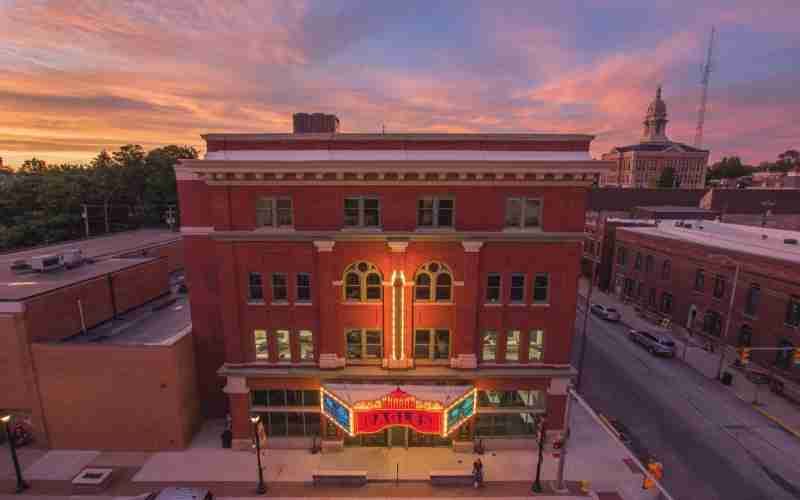The first thing you need to know is that Wabash is just a corruption of Ouabache, a French word meaning, “I bet you 20 francs some Englishmen will end up corrupting this.”
Not really.
In truth, Ouabache is the word that 17th-century Frenchmen wrote down after they heard Miami tribespeople say, “Waapaahšiiki.” We don’t know much about these Frenchmen, but I’d say it’s fair to guess that they were hard of hearing.
Waapaahšiiki was how Miami tribespeople referred to water moving over a white limestone river bottom. These days, you can still see the moving water, but you have to take the white limestone river bottom on faith.
What you won’t have to take on faith is this: The city of Wabash and environs offer more than a person can see, hear, eat, drink, and do in a single day. I can prove it because I tried to pack everything into a single day, but I failed.
Go back in History
My first stop in town was the Wabash County Historical Museum. Wabash has perhaps the swankiest history museum in the region. It has interactive exhibits, a movie theater, virtual moped rides, and a magnificent head of hair (minus the head).
Art made from human hair was a Victorian fad, and the Wabash County Historical Museum has one of the largest examples in the United States: A harp created by a woman named Martha Holloway that incorporates the hair of 700 of her friends and relatives. Maybe 700 friends doesn’t sound like a lot to someone who has thousands of Facebook friends, but try asking 700 of them for their hair.
The museum has many artifacts and exhibits related to the life and career of industrialist Mark C. Honeywell, who built the Honeywell Center. I was tickled to learn that Honeywell had his own movie studio in Wabash and assisted in the creation of the 1939 film, Tarzan Finds a Son! You can watch a documentary on the making of the film at the museum.
Elephant Gone Wild
After you visit the museum, you’ll want to go to Modoc’s Market and get some coffee and coffee-adjacent foodstuffs. Of all the coffeehouses in the world that are named after rampaging elephants, Modoc’s is the best.
In November 1942, an elephant named Modoc, who was with a touring circus, got scared, stomped around downtown Wabash for a few hours, and then tromped across the countryside for five days. He was finally recaptured — unharmed, but not before he became a national story.
The articles written about this at the time are pretty colorful; they’re filled with obviously invented details. When circus staffers tried to use two other elephants to lure him back, Modoc allegedly “answered (their trumpeting) with elephantine sneers from a safe distance,” according to the Associated Press.
Modoc must have been a very gifted pachyderm, indeed. Not only could he sneer, but he could sneer loudly enough for other elephants to hear.
When I visited Wabash, I overheard an elderly gentleman on the sidewalk telling the story of Modoc to a group of younger companions. Although, when I tried to transcribe his version of the event, all I could write was Ouabache. It made me feel kindlier toward those hearing-impaired 17th-century Frenchmen.
The Feeling was Electric
One of Wabash’s non-elephantine claims to fame has to do with electricity.
On March 31, 1880, Wabash became the first electrically lighted city in the United States.
One of the four 3,000 candlepower Brush Arc Lamps that were used to accomplish this feat is on display in the courthouse.
Looking at it, you may have trouble seeing its resemblance to the bulb in your floor lamp. In fact, you’re far more likely to see its resemblance to something Dr. Frankenstein used to reanimate his monster.
“People stood overwhelmed with awe, as if in the presence of the supernatural,” a journalist wrote at the time. “Men fell on their knees, groans were uttered at the sight and many were dumb with amazement.”
The journalist was referring to people’s reaction to the light, not people’s reaction to Frankenstein’s monster.
If you want to grab a bite to eat in Wabash, there are several great options. The venerable Market Street Grill, one of Wabash’s oldest and finest eating establishments, is a given.
I had the opportunity to watch the staff get ready for a busy Saturday dinner service, and I don’t recall ever seeing waitpersons who enjoyed each other’s company as much as those folks seemed to.
One of the Market Street Grill’s claims to fame is Drunken Chicken, a wine-accented dish devised by chef Marcy Rife, who has been with the restaurant the entire time it has been open.
Comfort Food
A couple of miles outside of downtown, you’ll find Harry’s Old Kettle Pub & Grill. Harry Kilmer is the former chef at Eugenia’s, the restaurant inside the Honeywell Center. The Old Kettle Pub has been there for many years, but it has only been Harry’s Old Kettle Pub since 2013.
The Old Kettle Pub was a favorite hangout of Kilmer and his wife when he was working at Eugenia’s. When the Old Kettle Pub was put up for sale, Kilmer decided to purchase it and turn a room in the back into a professional kitchen. As he was in the process of making these expensive renovations, Kilmer won a national Small Business Revolution contest with a grand prize of $500,000.
These days, Kilmer offers comfort food to his patrons that is prepared to the exact specifications of a university-trained chef. His renowned mac and cheese, the recipe for which he tinkered with for years, is creamy and light and better than your grandmother’s mac and cheese, even if her last name is Kraft.
Travelin’ down the River
One of the best, and newest, things to do in the region during the summer is to take a canoe ride down the river from Lagro to downtown Wabash. This experience is provided by White Rock Recreation, which is owned by Parker Beauchamp. They also own Inguard Insurance of Wabash, the 13-24 Drive-In, and a 13-acre island on the river.
White Rock Recreation will take you in a bus up to the island in Lagro and give you a canoe or kayak that you can use to float to White Rock’s headquarters in downtown Wabash. There you can get a treat at Beauchamp’s Riverfront Sweets and Eats.
In Lagro, I visited a real canal lock from the Wabash & Erie Canal days. A lock is something that raises and lowers watercrafts between waterways. You can stand amid this lock and imagine that you are a boat being raised and lowered. This is especially easy to imagine if you gained as much weight as I did during the pandemic.
Hanging Around
People don’t come to northern Indiana to experience startling geological features any more than they go to Kansas to dive on a coral reef. But, in Lagro, you can both climb a startling geological feature and dive on a coral reef. You can even do both at the same time!
This feature is called Hanging Rock.
It contains a portion of a prehistoric coral reef called the Sirulian. After I climbed to the top, I found a group of hikers enjoying a snack. I considered asking them if they were having a picnic at Hanging Rock, but I am getting really tired of young people staring at me blankly in reaction to my moth-eaten pop cultural references.
Covered Bridge
In Roann, about 15 miles from Lagro and 11 from Wabash, there is the Roann Covered Bridge. As I took photos of this historic bridge, I awaited the arrival of an unhappy housewife named Francesca with an Italian accent so convincing that it could only have been created by Meryl Streep.
I left when it occurred to me that I’m the sort of person who would attract one of Clint Eastwood’s less glamorous co-stars. Probably the orangutan.
If lodging is what you’re looking for, then proceed any which way you can to the Charley Creek Inn.
It originally opened as a hotel in 1920. In 2007, Wabash philanthropist Richard Ford purchased the building and refurbished the hotel. When it reopened in 2010 as the Charley Creek Inn, its 80 rooms had been reduced to 25 plus five suites.
The restoration of the space included a return to 1920s splendor.
The building now also contains a restaurant, a piano bar, an ice cream and candy shop, and a wine and cheese store.
Honeywell Properties
The Charley Creek Inn is one of Wabash’s crown jewels. Two more are the Honeywell Center and the Eagles Theatre, both owned by the Honeywell Foundation.
Eagles Theatre underwent a two-year, $18 million renovation that debuted in February 2020 — only to get shuttered by COVID-19.
Eagles will blow off the pandemic dust when it hosts Sammy Hagar and the Circle on August 13.
Honeywell Foundation CEO Tod Minnich gave me a tour of the theater, and it’s a gorgeous facility. Its historic character has been preserved, but there are plenty of new amenities: Two viewing suites, upgraded seating and sound, classrooms, spaces for video production and editing, and a small second theater in a sub-basement that was dug for the purpose.
Tod was kind enough to also take me on an “oddities” tour of the Honeywell Center. One of the things I have always loved about the Honeywell Center is its unusual historical features.
For example, it has a small roller rink that can be rented out for private parties.
Many backstage walls behind the Ford Theatre are covered completely with the signatures of, and even artwork by, most of the performers who have graced the Ford Theatre’s stage.
I am not yet famous enough to add my name, but I am referenced on a wall of one of the bathrooms.
I wish I knew who put that there.
You can rent spaces in the Honeywell Center that had other uses in the life and work of Mark Honeywell. For example, the Tower Room, which was once used as a board room. It has high ceilings, wall-length frescos, and a generally regal mien.
And then there’s the Olivette Room.
It is a recreation of Honeywell’s Wabash basement, which was itself a recreation of a cabin on Mark Honeywell’s yacht. The walls are painted to resemble the view from the “boat” off the Florida coast.
I had been in the Olivette Room before, but as I leaned on the bar talking to Tod, I saw something I had never seen before.
As part of my research into Mark Honeywell, I looked into early Tarzan films. The second Johnny Weissmuller film, Tarzan and His Mate, was produced before Motion Picture Production Code censorship guidelines, aka the Hays Code, were instituted. It features a scene in which Weissmuller as Tarzan and Maureen O’Sullivan as Jane swim naked together. This footage is artfully done and tasteful, by modern standards, but it must have been hot stuff in 1934.
Above the bar there are two portholes containing an undersea diorama, sort of the way Easter sugar eggs contain panoramic scenes. The undersea scene depicted in these portholes is a naked man and woman swimming underwater.
Folks, it looked to me to be highly reminiscent of that Tarzan footage. Tod disagreed with me, but I prefer to believe that Honeywell was a big fan of Tarzan and His Mate, or that he wasn’t a big fan of the Hays Code.
 Submit Your Event
Submit Your Event



